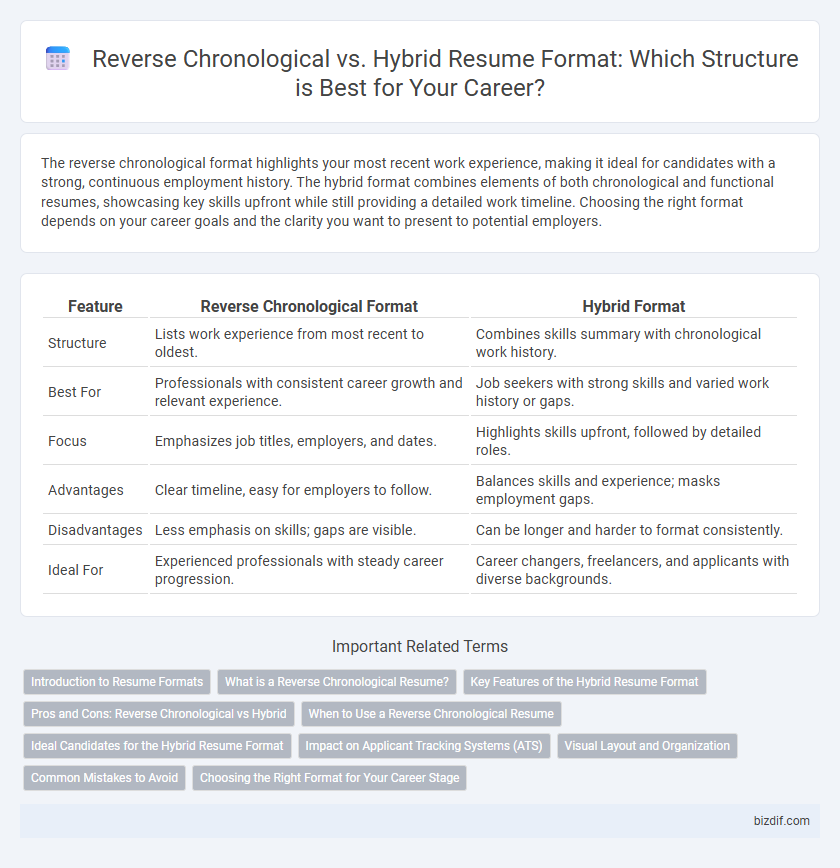The reverse chronological format highlights your most recent work experience, making it ideal for candidates with a strong, continuous employment history. The hybrid format combines elements of both chronological and functional resumes, showcasing key skills upfront while still providing a detailed work timeline. Choosing the right format depends on your career goals and the clarity you want to present to potential employers.
Table of Comparison
| Feature | Reverse Chronological Format | Hybrid Format |
|---|---|---|
| Structure | Lists work experience from most recent to oldest. | Combines skills summary with chronological work history. |
| Best For | Professionals with consistent career growth and relevant experience. | Job seekers with strong skills and varied work history or gaps. |
| Focus | Emphasizes job titles, employers, and dates. | Highlights skills upfront, followed by detailed roles. |
| Advantages | Clear timeline, easy for employers to follow. | Balances skills and experience; masks employment gaps. |
| Disadvantages | Less emphasis on skills; gaps are visible. | Can be longer and harder to format consistently. |
| Ideal For | Experienced professionals with steady career progression. | Career changers, freelancers, and applicants with diverse backgrounds. |
Introduction to Resume Formats
Reverse chronological format highlights work experience starting with the most recent job, emphasizing career progression and stability. Hybrid format combines the strengths of reverse chronological and functional formats by showcasing key skills alongside a detailed work history. Selecting the right resume format depends on the candidate's career goals, work experience, and the specific job requirements.
What is a Reverse Chronological Resume?
A Reverse Chronological Resume lists work experience starting with the most recent position first, emphasizing a clear career progression and stability. This format highlights job titles, companies, and dates of employment, making it ideal for candidates with consistent work histories in the same field. Employers favor this structure for its simplicity and easy assessment of an applicant's professional timeline.
Key Features of the Hybrid Resume Format
The Hybrid resume format combines the strengths of both reverse chronological and functional formats by highlighting relevant skills at the top, followed by a detailed chronological work history. It effectively showcases core competencies and professional achievements while maintaining a clear timeline of job experience. This format is ideal for candidates with diverse skill sets or those transitioning careers, ensuring recruiters quickly find critical qualifications and job progression.
Pros and Cons: Reverse Chronological vs Hybrid
Reverse chronological resumes highlight work experience in descending order, making it easier for employers to see recent roles but may underemphasize skills or gaps. Hybrid resumes combine chronological work history with a skills-based section, providing flexibility to showcase relevant abilities alongside consistent employment. While the reverse chronological format suits candidates with steady career progression, the hybrid format is ideal for those with varied experiences or career changes, balancing achievements and timelines.
When to Use a Reverse Chronological Resume
A reverse chronological resume is ideal for candidates with a solid work history in the same industry, demonstrating career progression through recent roles listed first. This format highlights consistent employment and relevant experience, making it easier for hiring managers to track professional growth. Use it when your job history aligns closely with the position you're applying for and you want to emphasize stable employment and achievements.
Ideal Candidates for the Hybrid Resume Format
The hybrid resume format suits professionals with diverse skill sets and varied work experiences seeking to highlight both their achievements and employment history. Ideal candidates include career changers, freelancers, and those with gaps in employment who want to emphasize relevant skills while maintaining a clear chronological work timeline. This format effectively balances functional and chronological elements to showcase adaptability and expertise to potential employers.
Impact on Applicant Tracking Systems (ATS)
The reverse chronological resume format is highly favored by Applicant Tracking Systems (ATS) due to its straightforward structure, making keyword parsing and timeline recognition more efficient. Hybrid formats combine elements of both chronological and functional resumes, which can sometimes confuse ATS algorithms if not carefully organized, potentially leading to important information being overlooked. Prioritizing clear section headers and consistent formatting enhances ATS compatibility regardless of the chosen resume style.
Visual Layout and Organization
The reverse chronological format prioritizes a clean, streamlined visual layout by listing work experience in descending order, emphasizing recent roles with clear dates and consistent formatting. The hybrid format combines this structure with a functional emphasis, allowing for distinct skill sections alongside chronological experience, enabling a balanced organization that highlights both competencies and employment history. Effective use of headers, bullet points, and white space in both formats enhances readability and guides recruiters through the candidate's professional narrative efficiently.
Common Mistakes to Avoid
Common mistakes in resume writing include using an inconsistent reverse chronological format that confuses employers or omits key dates and job titles. Avoid cluttering a hybrid format by blending skills and work history without clear separation, which can obscure professional growth and achievements. Ensure each section is clearly defined and tailored to the job description to enhance readability and impact.
Choosing the Right Format for Your Career Stage
Choosing the right resume format depends on your career stage and experience. The reverse chronological format highlights a clear, linear work history, ideal for candidates with consistent employment and upward career progression. The hybrid format combines skills and experience, making it effective for professionals with diverse roles, career gaps, or those transitioning industries.
Reverse Chronological vs Hybrid Format Infographic

 bizdif.com
bizdif.com